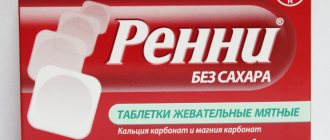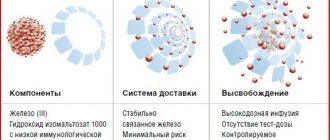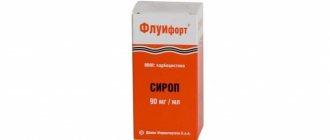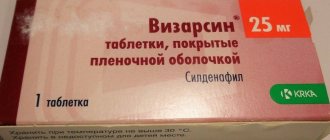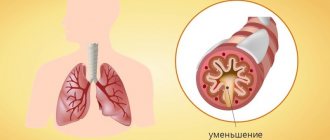All cough medicines for oral administration can be divided into several groups depending on the active substance: entirely from herbal ingredients, based on ambroxol, bromhexine, acetylcysteine or carbocysteine.
Manufacturers offer a wide selection of carbocysteine-based drugs for adults and children.
Description of the substance
Carbocisteine is a substance that belongs to the group of secretolytics and stimulants of motor function of the respiratory tract, promotes coughing and makes sputum less viscous.
Has several therapeutic effects:
- normalizes the viscosity and mobility of bronchial secretions;
- promotes the outflow of pathological discharge from the paranasal sinuses;
- has an anti-inflammatory effect;
- promotes the movement of cilia of ciliated cells lining the respiratory tract and the movement of mucus.
Carbocisteine enhances the effect of taking antibiotics and glucocorticoids. Combines well with theophylline, which relieves bronchospasm. It is not used together with centrally acting antitussives.
Clinical effect of the drug
It was synthesized in the 30s of the last century, and began to be used starting in 1960 - for the treatment of respiratory infections as a mucoregulatory agent. The therapeutic effect of carbocisteine is determined by processes that normalize the functioning of gland cells. The medicine has a beneficial effect on goblet cells of the bronchial tree mucosa, activating their enzyme, sialic transferase. Carbocisteine normalizes the viscosity of mucous discharge, as it regulates the level of sialic acid and fucose in the respiratory tract. As a result, the structure of the bronchial epithelium and mucociliary transport is restored.
Carbocysteine also restores the structure of the mucous membranes, regulating the functioning of goblet cells of the respiratory tract (especially in the terminal sections of the bronchi). In general, the drug:
- reduces mucus hyperproduction;
- activates the work of the bronchial epithelium;
- helps accelerate mucociliary clearance;
- quickly stops the inflammatory process.
Data obtained from modern research have shown that carbocysteine has a pronounced anti-inflammatory and antioxidant effect. Thanks to it, anti-inflammatory cytokines reduce their activity in the respiratory organs, and the damaged endothelial membrane is restored in a short time. As a result, cough sensitivity, which is closely related to these processes, becomes less. In addition, carbocisteine is highly effective in the presence of oxidative stress, reducing the inflammatory process that reactive oxygen species can cause.
The therapeutic effect of the drug extends to all levels of the respiratory tract:
- nasopharynx;
- bronchi;
- sinuses;
- middle ear.
The main clinical symptom for which carbocysteine should be prescribed is cough and viscous sputum with difficulty in clearing it. The drug helps to normalize the elasticity and viscosity of mucous discharge, with the subsequent restoration of mucociliary clearance.
Indications and contraindications
Medicines containing carbocysteine are prescribed for pathologies of the respiratory system, which are characterized by the formation of thick and difficult to separate secretions. These include: acute and chronic bronchitis, tracheobronchitis, pneumonia, bronchiectasis, whooping cough, tracheitis, sinusitis, otitis media. The drug is also prescribed before diagnostic procedures - endoscopy of the lungs and bronchi, x-ray of the bronchial tree with a contrast agent.
As contraindications, the instructions for carbocysteine contain:
- increased sensitivity to the substance;
- stomach and duodenal ulcers;
- kidney dysfunction;
- kidney disease with damage to the renal glomeruli in the acute phase;
- cystitis;
- During pregnancy and breastfeeding.
As a rule, treatment with the drug does not cause adverse reactions. However, the manufacturer indicates that taking carbocysteine can cause nausea and vomiting, pain in the stomach, diarrhea, allergies in the form of skin rashes, Quincke's edema, and bleeding from the gastrointestinal tract.
How to use carbocisteine
Preparations with carbocisteine are used only internally. The regimen and dosage depend on the form of release, the concentration of the main substance and the age of the patient.
For adults, carbocisteine is prescribed in capsules or syrup 5%:
- at the beginning of therapy, two capsules or 15 ml of syrup three times a day;
- if the condition improves - one capsule or 10 ml of syrup three times a day.
Children are prescribed only 2% syrup:
- at the age of two to five years – 2.5-5 ml four times a day;
- from five to twelve years - 10 ml of syrup four times a day.
Carbocisteine in pediatrics
Drugs in this group are actively prescribed by pediatricians in the treatment of bronchopulmonary diseases in children. Especially for young patients, medications are produced with a smaller amount of the main active ingredient, they have a pleasant taste and are easily tolerated. The main ones include:
- Fluditec 2% - produced in France, has a pleasant banana taste, helps thin mucus and remove it in case of bronchitis, tracheitis, bronchial asthma, as well as reduce viscosity and increase the detachability of thick mucus in case of rhinitis, sinusitis, otitis media. Allowed for children from two years of age. If prescribed by a doctor, it can be used in the treatment of newborns from 1 month;
- Bronchobos 2.5% – produced in Bosnia and Herzegovina, prescribed for acute and chronic diseases of the bronchi and lungs with difficulty in mucus discharge, for inflammatory diseases of the middle ear and sinuses. Suitable for children from three years old. It has a thinner consistency compared to Fluditec and a raspberry flavor;
- Libexin Muco 2% - produced in Germany, has similar indications, approved for children from two years of age.
The place of carbocisteine in outpatient pediatric practice
Disruption of the processes of mucus secretion in the respiratory tract is an important component in the pathogenesis of both acute and chronic bronchopulmonary diseases, causing natural clinical manifestations [1–3]. Recent studies have shown that inflammation and oxidative stress are leading triggers of airway mucus overproduction and secretion, which is closely correlated with respiratory disease outcomes. Many medical communities around the world have officially recognized that hypersecretion of mucus in the respiratory tract plays a significant role in respiratory diseases [4].
Therefore, mucolytic therapy is an indispensable component in the treatment of acute and chronic respiratory diseases in children [1]. In pediatric practice, both traditional herbal remedies and drugs of synthetic origin are widely used [2]. The most advanced class of indirectly acting mucoactive drugs, which have both mucoregulatory and mucolytic properties, include carbocisteine and its derivatives [1, 2]. We have previously drawn the attention of pediatricians to this promising group of drugs [1, 5–9].
Carbocysteine was synthesized in 1930 and since 1960 has been used for respiratory diseases as a mucoregulator. The mucoregulatory effect of carbocysteine is due to the normalization of the secretory function of glandular cells. Carbocisteine affects the activity of the enzyme of goblet cells of the bronchial mucosa: sialic transferase, which regulates the balance between sialomucins and fucomucins. Experimental studies on animal models have shown that carbocysteine increases chloride transport in the epithelium of the respiratory tract, which is one of the mechanisms of its mucoregulatory effect [10]. Carbocysteine has been noted to inhibit TNF-α-induced increases in viscosity and sialyl-Lewis X epitopes on the MUC5AC fusion protein. The data obtained indicate that carbocisteine helps normalize mucus viscosity by normalizing the content of fucose and sialic acid in respiratory tract mucins [11]. Due to this, it has a positive effect on mucociliary transport and restores the structure of the respiratory epithelium [1, 11]. Under the influence of carbocisteine, the mucous membrane is regenerated, the number of goblet cells is reduced, especially in the terminal bronchi, and, as a result, mucus production decreases, the activity of the ciliated epithelium is activated, mucociliary clearance is accelerated, which contributes to a more rapid relief of inflammation [13]. The latter is achieved by the fact that carbocisteine has anti-inflammatory activity: both direct (kinin-inhibitory activity of sialomucins) and indirect (improvement of capillary perfusion, microcirculation) [10–12, 14].
Analysis of data from modern clinical and experimental studies indicates the pronounced anti-inflammatory and antioxidant activity of carbocysteine [12, 14]. Carbocysteine preparations help reduce the migration of pro-inflammatory cytokines into the respiratory tract, restore damaged endothelium and associated cough sensitivity [15]. As a result of an experimental study, it was proven that carbocisteine preparations have a protective effect against oxidative stress, reducing the activity of inflammation caused by reactive oxygen species. During a comparative assessment of various methods of expectorant therapy in patients with bronchial asthma, it was found that after a course of carbocysteine, the cough threshold according to a functional test with capsaicin was significantly higher than after treatment with ambroxol or placebo [15]. Carbocysteine inhibits the adhesion of pathogenic bacteria to the epithelium of the respiratory tract, which helps reduce bacterial contamination of the respiratory tract [16]. Carbocysteine changes the surface structure of Streptococcus pneumoniae, which leads to a decrease in its fixation on respiratory epithelial cells [17]. The study revealed that under the influence of carbocysteine, the adhesive properties of the epithelium of the upper respiratory tract decrease, i.e., the amount of Haemophilus influenzae captured by cells decreases, which, according to the authors, can help reduce the frequency of respiratory infections [18]. Clinical experience shows that carbocisteine combines well with inhaled glucocorticosteroids and bronchodilators and increases the effectiveness of antibacterial therapy [5]. It has been proven that with the simultaneous use of carbocisteine and amoxicillin during exacerbation of chronic bronchitis, the content of the antibiotic in the bronchial secretions of patients increases significantly, which provides a synergistic effect and better eradication of pathogenic microorganisms [16].
There is experimental evidence that carbocisteine reduces the expression of receptors for the human influenza virus in epithelial cells of the respiratory tract by inhibiting the NF-kappaB factor and increasing the pH level in cell endosomes [19]. The results of an experimental study indicate that carbocysteine reduces inflammatory processes in the respiratory tract and hyperproduction of mucus when exposed to a conditioned stimulus (tobacco smoke) after infection with the influenza virus through activation of the NF-E2-related factor [20]. As Japanese scientists have shown, carbocysteine inhibits the development of rhinovirus infection in human tracheal epithelial cells [21]. It affects the inflammatory process in the respiratory tract during viral infection by reducing the production of IL-6, IL-8, and soluble forms of intercellular adhesion molecules (ICAM-1). There is evidence of a sustained increase in the level of secretory immunoglobulin A while taking carbocisteine, which persists for a long time after the end of treatment [5, 16, 22].
The effect of carbocysteine is manifested at all levels of the respiratory tract: both at the level of the mucous membrane of the bronchial tree, and the nasopharynx, sinuses and middle ear [1, 3, 23, 24]. A direct indication for the use of carbocisteine is a cough with viscous, difficult to separate sputum [5, 23].
Carbocysteine restores the viscosity and elasticity of mucus, improves mucociliary clearance, and restores IgA secretion. Poor solubility and low pH required the development of an adapted dosage form [1, 5, 6, 25, 26].
In particular, Fluditec® syrup is a well-buffered solution of carbocisteine, which is available in the form of 5% (for adults) and 2% (for children) syrup with a pleasant taste. According to G.L. Balyasinskaya et al., treatment with Fluditek® (compared to ambroxol) in children under 5 years of age significantly reduced the average duration of broncho-obstructive syndrome and cough, as well as the duration of hospitalization [27]. When examining children with acute respiratory infections (ARI) of the lower respiratory tract aged 2 to 12 years who received carbocysteine (Fluditek®) (main group) and acetylcysteine (control group), N. A. Solovyova et al. higher clinical efficacy of therapy was shown, the safety and good tolerability of mucoactive therapy in the main group was confirmed [24].
As a result of a comparative assessment of the clinical effectiveness of carbocisteine (Fluditec®) and expectorant herbal preparations, it was revealed that carbocisteine is highly effective and safe in children with repeated respiratory infections of the lower respiratory tract aged 2 to 17 years. It was noted that the administration of carbocysteine in the first days of the disease significantly reduced its duration and the duration of hospitalization, reduced the duration of cough and moist rales in the lungs, and contributed to an increase in local immunity (sIgA), in contrast to patients in the comparison group [5, 25].
In a comparative study in children aged 3 to 8 years with diseases of the upper respiratory tract (rhinitis, adenoiditis) receiving carbocysteine, its higher clinical effectiveness was shown in the form of discharge and reduction of nasal secretions, reduction of swelling of the nasal mucosa, normalization of nasal breathing and exfoliative data cytograms of nasal secretions compared with patients in the control group (without the use of mucolytics) [28]. Similar data were obtained by the authors who determined the effect of the drug Fluditek® in combination with antibacterial therapy (penicillin antibiotics, 3rd generation cephalosporins and macrolides) and decongestants in children with acute rhinosinusitis, acute exudative otitis media, acute nasopharyngitis [29].
It should be noted that there are numerous publications on the high therapeutic effectiveness of carbocisteine in adult patients with chronic obstructive pulmonary disease (reducing the frequency of exacerbations and improving the quality of life of patients) [30, 31]. During a clinical study of patients with chronic bronchitis, it was found that as a result of therapy with the inclusion of carbocisteine, sputum viscosity decreases 3.5 times, mucociliary transport is restored on the 4th day from the start of treatment, and there is a persistent “aftereffect” for 8 days after the end therapy [32]. The “aftereffect” effect of carbocysteine allows us to recommend it in courses for chronic lung diseases that require long-term mucoregulatory therapy. Data from numerous clinical studies indicate that there is no risk of excessive sputum thinning with the use of carbocisteine [1, 3, 5–9, 25, 27, 32].
According to clinical studies, carbocisteine has a high safety profile [31]. A systematic Cochrane review of 34 studies involving 2064 children over two years of age to determine the effectiveness and safety profile of mucolytics for ARI concluded that carbocysteine is safe in children over two years of age [33].
We emphasize that the selection of mucoregulators is especially important in the treatment of diseases of the lower respiratory tract in children of early and preschool age, since the tendency to exudation and swelling of the bronchial mucosa, pronounced overproduction and increased viscosity of mucus, and narrowness of the respiratory tract are the main pathogenetic factors.
An analysis of modern literature has shown the high effectiveness and safety of prescribing carbocisteine for the following diseases: 1) acute, especially repeated, recurrent and prolonged respiratory infections of the lower respiratory tract, accompanied by diffuse moist rales in the lungs, hyperproduction of sputum; 2) acute broncho-obstructive syndrome in ARI (in combination with bronchodilators), accompanied by viscous, difficult to separate sputum, deterioration of its evacuation; 3) chronic bronchitis.
A positive mucoactive effect is achieved with complex treatment, including a protective regimen, adequate hydration, a rational diet, etiotropic therapy (antiviral drugs, antibiotics as indicated). In order to improve the drainage function of the lower respiratory tract, kinesitherapy and breathing exercises are used.
In general, carbocisteine is a modern mucoactive drug with a mucoregulatory effect, which makes it one of the most popular in the treatment of both acute and chronic, recurrent bronchopulmonary pathology in children.
Literature
- Mizernitsky Yu. L., Melnikova I. M. Mucolytic and expectorant pharmacotherapy for lung diseases in children. M.: Publishing House "Medpraktika-M", 2013. 120 p.
- Mizernitsky Yu. L. Expectorants and mucolytics in the treatment of bronchopulmonary diseases in children. Guide to pharmacotherapy in pediatrics and pediatric surgery / Ed. ed. Tsaregorodtseva A. D., Tabolina V. A. T. 1. Pharmacotherapy in pediatric pulmonology / Ed. Kaganova S. Yu. M.: Medpraktika-M, 2002. P. 7: 123–140.
- Chuchalin A. G., Abrosimov V. N. Cough. M.: GEOTAR-Media, 2021. P. 152.
- Shen Y., Huang S., Kang J. et al. Management of airway mucus hypersecretion in chronic airway inflammatory disease: Chinese expert consensus (English edition) // Int J Chron Obstruct Pulmon Dis. 2018; 13:399–397.
- Ermakova I. N., Mizernitsky Yu. L. Carbocysteine (Fluditek) in the complex therapy of recurrent respiratory infections of the lower respiratory tract in children // Zemsky doctor. 2012; 5 (16): 12–16.
- Mizernitsky Yu. L. Carbocysteines in modern therapy of lung diseases in children // Ros. Vestn. perinatol and pediatrics. 2016; 61 (5): 19–23.
- Batozhargalova B. Ts., Mizernitsky Yu. L. The problem of smoking among adolescents and the rationale for the role of anti-tuxedo programs in the prevention of respiratory pathology and rehabilitation of chronic lung diseases // Children's and adolescent rehabilitation. 2011; 2 (17): 52–60.
- Mizernitsky Yu. L., Melnikova I. M., Batozhargalova B. Ts. et al. Clinical effectiveness of lysine salt of carbocisteine in acute and chronic bronchopulmonary diseases in children // Issues. pract. pediatrics. 2011; 6 (5): 69–64.
- Mizernitsky Yu. L., Melnikova I. M., Batozhargalova B. Ts. et al. Mucolytic therapy for diseases of the lower respiratory tract // Doctor. 2009; 12: 78–82.
- Hooper C., Calvert J. The role for S-carboxymethylcysteine (carbocisteine) in the management of chronic obstructive pulmonary disease // Int J Chron Obstruct Pulmon Dis. 2008; 3 (4): 659–669.
- Ishibashi Y., Takayama G., Inouye Y., Taniguchi A. Carbocisteine normalizes the viscosity property of mucus through regulation of fucosylated and sialylated sugar chain on airway mucins // Eur J Pharmacol. 2010, Sep 1; 641(2–3):226–228.
- Yoshida M., Nakayama K., Yasuda H. et al. Carbocisteine inhibits oxidant-induced apoptosis in cultured human airway epithelial cells // Respirology. 2009. No. 14 (7): 1027–1034.
- Novikov Yu. K. Mucociliary transport as the main mechanism of lung protection // Breast Cancer. 2007. 15 (5): 357–360.
- Maccio A., Madeddu C., Panzone F., Mantovani G. Carbocysteine: clinical experience and new perspectives in the treatment of chronic inflammatory diseases // Expert Opin Pharmacother. 2009. 10(4): 693–703.
- Ishiura Y., Fujimura M., Yamamori C. et al. Effect of carbocysteine on cough reflex to capsaicin in asthmatic patients // Br J Clin Pharmacol. 2003. 55 (6): 504–510.
- Houtmeyers E., Gosselink R., Gayan-Ramirez G., Decramer M. Effects of drugs on mucus clearance // Eur Respir J. 1999, Aug; 14(2):452–467.
- Suer E., Sayrac S., Sarinay E. et al. Variation in the attachment of Streptococcus pneumoniae to human pharyngeal epithelial cells after treatment with S-carboxymethylcysteine // J Infect Chemother. 2008, Aug; 14 (4): 333–336.
- Ndour C., Ahmed K., Nakagawa T. et al. Modulating effects of mucoregulating drugs on the attachment of Haemophilus influenzae // Microb. Pathog. 2001. 30(3): 121–127.
- Yamaya M., Nishimura H., Shinya K. et al. Inhibitory effects of carbocisteine on type A seasonal influenza virus infection in human airway epithelial cells // Am J Physiol Lung Cell Mol Physiol. 2010, Aug; 299(2):160–168.
- Yageta Y., Ishii Y., Morishima Y. et al. Carbocisteine reduces virus-induced pulmonary inflammation in mice exposed to cigarette smoke // Am J Respir Cell Mol Biol. 2014, May; 50(5):963–973.
- Yasuda H., Yamaya M., Sasaki T. et al. Carbocisteine inhibits rhinovirus infection in human tracheal epithelial cells // Eur. Respira. J. 2006. 28 (1): 51–58.
- Bogdanova A.V. Efficacy of the drug Fluifort in the treatment of recurrent and chronic bronchitis in children/Pulmonology of childhood: problems and solutions. Vol. 5. M., 2005: 77–79.
- Majima Y., Kurono Y., Hirakawa K. et al. Efficacy of combined treatment with S-carboxymethylcysteine (carbocysteine) and clarithromycin in chronic rhinosinusitis patients without nasal polyp or with small nasal polyp // Auris Nasus Larynx. 2012, Feb; 39 (1): 38–37.
- Solovyova N. A., Kulakova G. A., Kurmaeva E. A. Mucoactive therapy in the treatment of acute respiratory infections in children // Practical Medicine. 2013. 6 (75): 188–195.
- Ermakova I. N. Efficacy of the drug Fluditec in the treatment of acute respiratory infections in frequently ill children // Pediatrics. 2007; 1:93–100.
- Delyagin V. M., Bystrova N. Yu. Antibacterial and mucoactive drugs. M.: Altus, 1999. P. 70.
- Balyasinskaya G.L., Timakov E.Yu. Experience of using the drug Fluditec in the treatment of acute obstructive bronchitis in young children // Russian Bulletin of Perinatology and Pediatrics. 2010. 55 (4): 45–49.
- Tarasova G. D., Ivanova T. V., Protasov P. G. Fluditec in the treatment of inflammatory diseases of the upper respiratory tract // Russian Otorhinolaryngology. 2005. 6 (19): 77–81.
- Balyasinskaya G.L., Lyumanova S.R., Landa R.I. The importance of mucoactive therapy in the treatment of acute sinusitis in children // Ros. otorhinolaryngol. 2006. No. 6 (25): 84–86.
- Esposito A., Valentino M.R., Bruzzese D. et al. Effect of carbocisteine in prevention of exacerbation of chronic obstructive pulmonary disease (CAPRI study): an observational study // Pulmonary Pharmacology & Therapeutics. 2021. DOI: 10.1016/j.pupt.2016.03.003.
- Berezhnoy V.V., Glyadelova N.P. Mucoregulatory drugs in the treatment of cough with respiratory pathology in children (literature review) // Modern Pediatrics. 2015. 8 (72): 57–66.
- Braga PC, Allegra L., Rampoldi C. et al. Long-lasting effects on rheology and clearance of bronchial mucus after short-term administration of high doses of carbocysteine-lysine to patients with chronic bronchitis // Respiration. 1990; 57(6):353–358.
- Chalumeau M., Duijvestijn YC Acetylcysteine and carbocysteine for acute upper and lower respiratory tract infections in pediatric patients without chronic broncho-pulmonary disease // Cochrane Database Syst Rev. 2013, May 31; (5): CD003124.
Yu. L. Mizernitsky*, 1, Doctor of Medical Sciences, Professor I. M. Melnikova**, Doctor of Medical Sciences
* Federal State Budgetary Educational Institution of the Russian National Research University named after. N. I. Pirogova, Ministry of Health of the Russian Federation, Moscow ** Federal State Budgetary Educational Institution of Higher Education Yaroslavl State Medical University, Ministry of Health of the Russian Federation, Yaroslavl
1 Contact information
The place of carbocysteine in outpatient pediatric practice / Yu. L. Mizernitsky, I. M. Melnikova For citation: Attending physician No. 9/2018; Page numbers in the issue: 42-45 Tags: respiratory diseases, cough, bronchi, mucociliary clearance
Carbocisteine in preparations for adults
Medicines for adults have a large dosage and a variety of dosage forms:
- Fluditec syrup 5% - approved for adolescents over 15 years of age and adults, prescribed with caution in the second and third trimester of pregnancy. Indications are similar to the drug for children;
- Bronchobos capsules - available in packs of 30 pieces, one containing 375 mg of carbocysteine. Allowed for children over 15 years of age and adults;
- Bronchobos syrup 5% - contraindicated for liver diseases, as it contains ethanol;
- Fluifort granules are allowed from the age of 16; adults only need one sachet per day. The course of treatment ranges from four days to six months. The contents are dissolved in water before use;
- Fluifort syrup - suitable for adults and children from 1 year.
Dosage form adapted for pediatric practice
Since this substance is poorly soluble in liquids and has a low pH level, experts have developed its formulation, adapted for both children and adults. This is a solution of carbocisteine, known as Fluditec (a syrup with a pleasant taste). The drug concentration for adults is 5%, for children - 2%. G.L. Balyasinskaya and co-authors report in their publications that Fluditek relieves bronchial obstruction and cough in young children much faster than the more popular Ambroxol. Also N.A. Solovyova and co-authors testify to the results of a survey of children 2-12 years old who regularly received carbocisteine. Studies have confirmed its high clinical outcome, safety and good tolerability in patients.
Fluditec syrup shows an equally high clinical effect if it is prescribed to children and adolescents who repeatedly become ill with ARVI affecting the lower respiratory tract. If prescribed in the first days of illness, the drug reduces its duration, as well as the duration of symptoms such as cough and pulmonary moist rales.
The drug can be safely prescribed to young children, as it does not have dangerous side effects.

